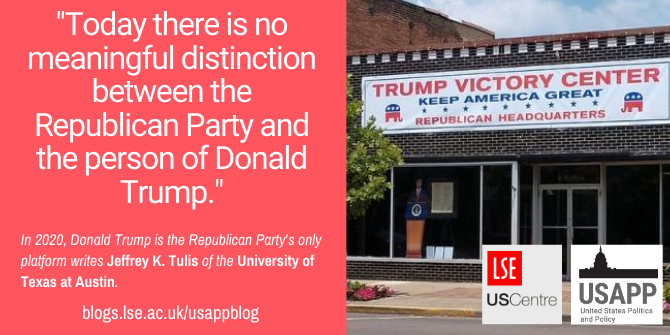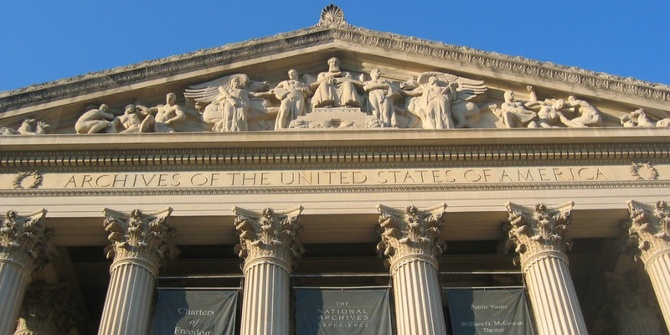 At this year’s Republican National Convention, for the first time in more than 150 years, the GOP decided not to agree a new party platform ahead of the 2020 presidential election, instead deciding to endorse President Trump’s priorities, whatever they might be. Jeffrey K. Tulis writes that, just when it seemed there were no more democratic norms for Donald Trump to tear up, he has done it again.
At this year’s Republican National Convention, for the first time in more than 150 years, the GOP decided not to agree a new party platform ahead of the 2020 presidential election, instead deciding to endorse President Trump’s priorities, whatever they might be. Jeffrey K. Tulis writes that, just when it seemed there were no more democratic norms for Donald Trump to tear up, he has done it again.
It is hard to overstate how significant it is that there is no Republican Party platform ahead of the 2020 presidential election for the first time since the party was founded a few years before the Civil War.
Despite the antipathy to political parties expressed by George Washington, James Madison, and others among the Founders, by the early nineteenth century national parties had been well established. They were remarkably successful—in various ways improving democratic politics and helping the system of government established by the Constitution to work better—to the extent that the American conception of political parties was transformed. They went from being considered significant dangers to necessary evils to essential defining features of a well-functioning democracy. Unlike parties from earlier historical regimes elsewhere, American parties were oriented to elections, less ideological, less polarized, and disconnected from competing religions or systems of ruling and therefore less connected to demagogues and potential autocrats.
But the virtues of the American party system became its source of political weakness. The idea that presidential candidates would be chosen by elites in smoke-filled rooms away from public scrutiny seemed undemocratic. So, about fifty years ago, the Democratic and Republican parties changed their rules for presidential selection to award nominations to candidates who won the most delegates via primary elections.
The party reforms of the 1960s and ’70s were meant to make political parties more democratic by giving ordinary citizens voice and power through the primaries. This new system meant that successful contenders would win their party’s nomination by direct popular appeal rather than by working their way up the ladder of pre-existing party organizations. Put another way, successful candidates would no longer come out of political parties, having been selected by them; rather, successful candidates would capture the party label by amassing sufficient delegates, and the party would reflect the priorities of and vision of the nominee. Under the old system, the party organization would persist; after the reforms, the successful nominee would appoint new party leadership.
Rewarding the skills of stump speaking and campaigning, these party reforms are now among the deep sources of demagoguery in presidential politics and the success of Donald Trump.

“Trump Victory Center” by Dan Keck is Public Domain.
Nevertheless, for decades there lingered residues of the parties’ earlier forms and functions. Most important of these was the practice of crafting a party platform during each presidential nominating convention. The platform would reflect the priorities of the candidate, of course. But the practice was more than a ritual—it was a mechanism to build a coalition around the successful candidate. Crafting a party platform gave voice to the losers in presidential primaries and thereby brought their supporters into a tent big enough to win and broad enough to govern.
Platforms are sometimes denigrated as mere rhetoric—like campaign promises by the candidates themselves. Often, platforms state positions that don’t get translated into law. But such rhetoric is never “mere rhetoric.” Setting forth what a party stands for can unite a diverse and potentially capacious coalition, and it can maintain a distinction between the party and its leader—even in an era of primary elections as partisan plebiscites.
Which brings us to this week. Just when one thought there were no more democratic norms for Donald Trump to tear up, he has done it again. He will be nominated by a Grand Old Party (GOP) convention that has decided not to fashion a new platform for this election. Instead, the Republican National Committee has offered its approval for whatever Trump thinks his priorities should be. And Trump has obliged with a bullet-point list of campaign pledges.
The RNC has offered the pandemic as an excuse for not consulting fellow Republicans and negotiating a new platform. But this is the same GOP that is eager to have meetings and rallies during the pandemic. And note that the Democratic Party had no trouble deliberating and crafting a traditional detailed party platform.
Today there is no meaningful distinction between the Republican Party and the person of Donald Trump. This GOP development takes populism to its limit—to the edge of fascism where whatever the leader says is the party position simply because he says it.
Please read our comments policy before commenting.
Note: This article gives the views of the authors, and not the position of USAPP – American Politics and Policy, nor the London School of Economics.
Shortened URL for this post: https://bit.ly/3jhPwsK
About the author
 Jeffrey K. Tulis – University of Texas at Austin
Jeffrey K. Tulis – University of Texas at Austin
Jeffrey K. Tulis is Professor of Government at The University of Texas at Austin, author of The Rhetorical Presidency, and co-author of Legacies of Losing in American Politics.







With Trump’s financial leadership over the years, I support and believe that Trump will be re-elected for president in 2020.